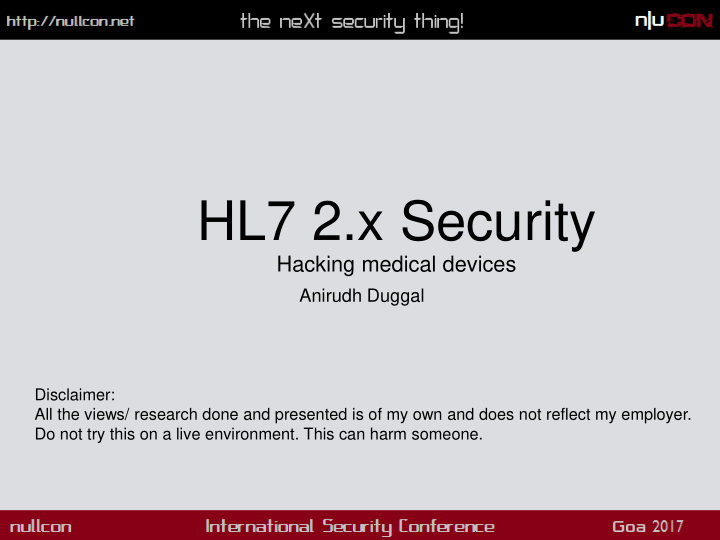



HL7 2.x Security Hacking medical devices Anirudh Duggal Disclaimer: All the views/ research done and presented is of my own and does not reflect my employer. Do not try this on a live environment. This can harm someone.
#whoAmI • Graduate Student at Northeastern University, Boston • Code occasionally • Follow null and CysInfo • Speak at conferences • Worked with Philips Healthcare @secure_hospital, @duggal_Anirudh
Agenda Security inside hospitals Why HL7 2.x Crash course in the protocol Understanding message Identifying ports Changing information Attacking devices Fuzzing Server attacks on HL7 2.x Defending HL7 and hospitals FHIR and changing threats
Securing hospitals Devices Patient monitors, X-Ray, Ultrasound, MRI Networks Administration network, Patient and guest network Protocols DICOM, HL7 2.x, 3.x, FHIR, HTTP, FTP Patient Records EHR / EMR – Electronic health records / Electronic medical records
HL7 = Health Level 7 “HL7’s Version 2.x (V2) messaging standard is the workhorse of electronic data exchange in the clinical domain and arguably the most widely implemented standard for healthcare in the world. This messaging standard allows the exchange of clinical data between systems. It is designed to support a central patient care system as well as a more distributed environment where data resides in departmental systems.” --Source: http://www.hl7.org/
In a nutshell HL7 2.x is everywhere Used by medical devices to support achieving interoperability EHR Compatibility software
HL 7 2.x crash course A Raw HL7 2.x (MLLP) message Raw Socket Vertical Tab / Start Block - \x0b MSH segment EVN segment PV segment File Separator / End Block - \x1c Carriage Return - \x0d
HL 7 2.x crash course | is the most common delimiter / field ^ means space MSH – message header segment Types of message we will be covering ADT – Admit Discharge and Transfer ORM – Order message ORU – Observation result RDE – Pharmacy order message Uses MLLP Protocol (Minimum Lower Layer Protocol) for sending messages
ADT - Admit Discharge and Transfer MSH|^~\&|SendingApplication|SendingFacility|RecievingApplication|RecievingFacility|20060529090131- 0500||ADT^A01^ADT_A01|01052901|P|2.5 EVN||||||200605290900 200605290901 PID|||56782445^^^UAReg^PI||Bob^Jerry^Q^JR||19620910|M||2028-9^^HL70005^RA99113^^XYZ|260 GOODWIN CREST DRIVE^^BIRMINGHAM^AL^35209^^M~NICKELL’S PICKLES^10000 W 100TH AVE^BIRMINGHAM^AL^35200^^O|||||||0105I30001^^^99DEF^AN PV1||I|W^389^1^UABH^^^^3||||12345^MORGAN^REX^J^^^MD^0010^UAMC^L||67890^GRAINGER^LUCY^X^^^M D^0010^UAMC^L|MED|||||A0||13579^POTTER^SHERMAN^T^^^MD^0010^UAMC^L|||||||||||||||||||||||||||20060529090 0 OBX|1|NM|^Body Height||1.80|m^Meter^ISO+|||||F OBX|2|NM|^Body Weight||79|kg^Kilogram^ISO+|||||F AL1|1||^ASPIRIN DG1|1||786.50^CHEST PAIN, UNSPECIFIED^I9|||A
ADT - Admit Discharge and Transfer Responsible for admit, discharge and transfer Contains: Patient information (PII) – name, age, address, height, weight, allergy Doctor information – attending doctor, referred doctor Patient visit details Allergy and diagnostics
ADT - Potential Entry Points Depends on the connected infrastructure Look at JavaScript and injection attacks Buffer overflows EMR systems will be prime target
ORM – Order message MSH|^~\&|SendingApplication|Hospital facility |RecievingApplication|Recieving Facility |20101111111214456+0700|SECURITY|ORM^O01^ORM_O01|MSG005010|P|2.6 PID||8838|4567830^345|AAAAA|Anirud^Duggal||20011010000000|M|Test||Street&comp1&comp2^AddLine2^Seattle^WA^ 98052^USA^H|USA|^^^^123^456^1111^7890|^^^^098^765^1111^4321|ENG^English|M||11111111111|111222333-SSN number|33333333333|||Washington|Y|2|||^am|20101111111214|Y|||||L-80700^Canine|L-80900^Weimaraner|666 PV1|1|I|4E^234^A^Good Health Hospital^^GT^^^Crowded|R|1234^4567||123^S^Sasikala^A^JR^DR^MD^|456^A^Deepshikha^S^JR^DR^MD^|789^H^Praj akta^A^JR^DR^MD^||||R|4|||101^M^Toshan^G^JR^DR^MD^||12345777^456|||||||||||||||||10||SZ^2^Diet||||||2010111111121445 6+0700|20101111111214456+0700 PV2|||High Fever|||||||||||||P||||||||DI|1| ORC|NW|X1234^HIS||||||||||ORC_12^test3^Practitioner3^A^^Dr||||||||||||Street&comp1&comp2^AddLine2^Seattle^WA^9805 2^USA^H OBR|1|X1234^HIS|R578^RIS|56782^X-Ray Chest||20101111111214456+0700|20101111111214456+0700||||||testOBR_13|||OBR_16^Check1||||||20101111111214456+ 0700||AU|F OBX|1|CWE|45^Systolic blood pressure^LN||10.532467105262732|kPa|||||S|||20150204025500.000+0000|a0g11000001QPcdAAG||^Manual entry by clinician
ORM – Order message Used to place orders for tests – x-ray, ultrasound, MRI and others Contains Patient information like ADT Will have order details – test to be conducted, facility location etc. Can be used to fingerprint more devices
ORM - Potential Entry points Changing PII Changing initial diagnostics Changing observations
ORU – Observation Result MSH|^~\&|SendingApplication|SendingFacility|||20140715112021||ORU^R01|D0715112021550d6fff|P|2.4 PID|||P1001010101||Duggal^Anirudh||19660909|Male|||||(347)651-3404 PV1||I|CSI^15^15-A^MOSES OBR|1|||86290005^Respiration Rate^SNM|||20140715105500||||||18 RPM RESP rgb(255,255,255) 1 STATUS 20140715145200 Resp Rate 18 RPM 15 Jul 2014 10:52 CALC MONITOR|20140715145200|||||||||||F|||||||||||||||^^^rgb(255,255,255)||Resp Rate 18 RPM 15 Jul 2014 10:52 OBX|1|NM|86290005^Respiration Rate^SNM||18|258984001^RPM^SNM^/min^Respirations per minute^ISO+||N|||F|||20140715105500||^Services^D OBX|2|ST|278195005^BodySystem^SNM||RESP|||N|||F|||20140715105500||^Services^D OBX|3|NM|224098002^DisplayOrderRow^SNM||1|||N|||F|||20140715105500||^Services^D OBX|4|ST|39801007^GridComponent^SNM||STATUS|||N|||F|||20140715105500||^Services^D OBX|5|ST|118170007^Source^SNM||MONITOR|||N|||F|||20140715105500||^Services^D OBX|6|ST|226035000^DisplayLabel^SNM||Resp Rate|||N|||F|||20140715105500||^Services^D
ORU – Observation Result Most important message in a live environment Contains patient observation Heart rate Oxygen levels Any other real-time / offline observation result Can be used to harm someone Changing diagnostics Blocking diagnostics
Potential entry points The observation (OBX) segment Specially reflected file downloads via the path
Recommend
More recommend